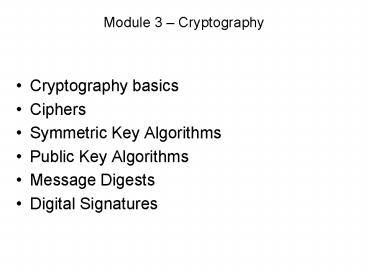Module 3 Cryptography PowerPoint PPT Presentation
1 / 15
Title: Module 3 Cryptography
1
Module 3 Cryptography
- Cryptography basics
- Ciphers
- Symmetric Key Algorithms
- Public Key Algorithms
- Message Digests
- Digital Signatures
2
Cryptography Basics
- Definitions (Encryption, Decryption, Plaintext,
Ciphertext) - Symmetric Key Algorithms
- Public Key Cryptography
Original Plaintext
Plaintext
Ciphertext
Encryption
Decryption
Key
Key
Original Plaintext
Plaintext
Ciphertext
Encryption
Decryption
Encryption Key
Decryption Key
Original Plaintext
Plaintext
Ciphertext
Encryption
Decryption
3
Types of cipher
- Stream cipher
- Each bit (or byte) is encrypted or decrypted
individually - Simple substitution ciphers (ROT13, XOR)
- Example - ROT13
- abcdefghijklmnopqrstuvwxyz
- nopqrstuvwxyzabcdefghijklm
- Block cipher
- A sequence of bits (or bytes) is used at each
step in the encryption and decryption process
(DES)
rot is insecure ebg vf vafrpher
4
Symmetric Algorithms
- Substitution (ROT13, Cryptoquotes)
- Transposition
- XOR
- One Time Pad
- DES
- IDEA
- RC2, RC4, RC5
Nsail otlnd t g sot. terh hcie eut rhw memo o
r
Not the mo st secure algorithm in the wor ld.
Not the most secure algorithm in the
world. Nsailotlndt g sot.terh hcie eut rhw
memo o r
5
Digital Encryption Standard (DES)
- A block cipher with a 56-bit key length
- Acutally a 64-bit number, but every 8th bit is
ignored - Operates on a 64-bit block of plain text at a
time - 64 bits of plaintext come in --gt 64 bits of
ciphertext come out - Performs 16 rounds, where in each round
- the input bits are permuted
- a key is applied to the resulting permutation
- The key is shifted before each round
- The same algorithm and key are used for
encryption and decryption, with a different key
schedule
6
Advanced Encryption Standard (AES)
- A block cipher with a 128-bit block size
- Key lengths of 128, 192, and 256 bits supported
- Operates on a 4x4 array of bytes
- Each round has four steps
- AddRoundKey (uses XOR operation with subkey)
- SubBytes (Each byte is replaced based on a lookup
table) - ShiftRows (bytes in each row are shifted to the
left) - MixColumns (each column is multiplied by a fixed
polynomial)
7
Public Key Cryptography
- A public key - private key pair are used, one for
encryption and the other for decryption
Public Key n - product of two primes, p and q
(p and q are secret) e - relatively prime to
(p-1)(q-1) Private Key d - e-1mod
((p-1)(q-1)) Encrypting c me mod
n Decrypting m cd mod n
8
- Let p3, q11
- npq33
- e must be relatively prime to (p-1)(q-1)20
- choose e 7, then d 7-1 mod 20 3
- Plaintext is 3,4,2 (m13, m24, m32)
- c1m1e mod n 37 mod 33 9
- c2 m2e mod n 47 mod 33 15
- c3 m3e mod n 27 mod 33 29
- Ciphertext is 9,15,29
- m1c1d mod n 93 mod 33 3
- m2c2d mod n 153 mod 33 4
- m3c3d mod n 293 mod 33 2
- Plaintext is 3,4,2
9
Message Digests
- A message digest is a one-way function which maps
the information contained in a (small or large)
file to a single large number, typically between
128 bits and 256 bits in length. - A good message digest function should have the
following properties - Every bit of the output is influenced by every
bit of the input - Changing a single bit in the input results in
every output bit having a 50 chance of changing - Given an input file, its corresponding digest,
and the digest function, it is computationally
infeasible to produce another input file which
maps to the same digest
10
Message
Digest Algorithm
MAC
Message
Hash
Secret Key
Block Cipher
Operation of a message digest function to produce
a message authentication code
Message Authentication Code
11
Message Digests (continued)
- HMAC
- The Hashed Message Authentication Code uses a
secret key in combination with a message digest
function to produce a secret message
authentication code - Since an attacker doesnt know the secret, the
attacker cannot produce a correct authentication
code if they alter the message in an way - SHA-1
- Developed by the NSA for use with the Digital
Signature Standard
12
Originator
Recipient
Transmitted Message
Message
Message
Hash Function
Hash Function
Message
Signature
Public Key
Digest
Decrypt
Private Key
Encrypt
Actual Digest
Expected Digest
Signature
If actual and expected match, the signature is
verified
RSA Digital Signature
13
Roles for Cryptography
- Authentication
- Digital signatures
- Authorization
- Distribution of lists of authorized users
- Confidentiality
- Information is scrambled in transit or on disk
- Integrity
- Digitally signed message digest codes
- Non-repudiation
- Cryptographic receipts
14
Cryptography cant
- protect unencrypted documents
- protect against stolen encryption keys
- protect against DOS (denial of service)
- protect against traffic analysis
- protect against a passerby
15
SSL
- Resides above TCP/IP on the protocol stack
- Adds numerous features to TCP, including
- Authentication to server (digital signature)
- Authentication to client (digital signature)
- Data confidentiality (encryption)
- Data integrity (Message authentication codes)

